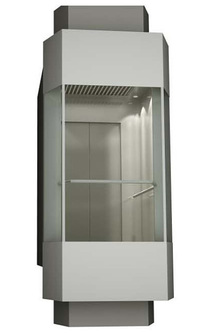Categories
Tags
-
#Passenger Elevator Factory
#villa elevator
#Observation Elevators
#bed elevator
#escalator
#freight lift manufacturers
#hydraulic elevator
#ecalator supplier
#lifting platform
#villa elevators
#passenger elevators
#car elevator
#passenger elevator
#elevator lift factory
#hydraulic freight elevator
#hospital elevator
#household elevators
Archives
Features of observation elevator
-
Observation Elevators usually adopt traction drive or hydraulic drive. Which drive method is selected depends on the height of the elevator and the hoistway conditions of the building. Since observation elevators have higher requirements for running quality, they usually adopt variable frequency speed regulation or hydraulic drive. Observation elevators generally do not require high operating speeds, and passengers generally want to stay in the car for a while to enjoy the scenery outside the car. The speed of the Observation elevator should be lower than the speed of similar objects, but it should not affect the vertical traffic in the building because the speed is too slow.
The first part, the car
The car of a observation elevator usually consists of two parts, namely the passenger area and the viewing area. The passenger area is adjacent to the elevator car door, and the viewing area is usually located at the rear of the car. The area ratio between the viewing area and the passenger area must be appropriate, otherwise it will increase the difficulty of car balancing. If the car width in the passenger area is set unreasonably, it will extend the time for passengers to enter the car. The novelty of the observation elevator lies in the use of transparent viewing curtain walls in the car viewing area. All personnel involved in the design, manufacturing and installation of the observation elevator must have an understanding of the glass assembly industry. Before designing a observation elevator car, the designer should consult the relevant building codes to understand the requirements for the use of glass materials in the elevator car and hoistway. During the design and installation process, the transparent viewing curtain wall shall not be used as a load-bearing component or structural component. The frame around the transparent viewing curtain wall should be sufficient to withstand all horizontal forces, including the forces that may be generated by elevator passengers, without deformation that affects safety performance. The car top and car bottom covers must be strong and firm, and they need to be light and easy to replace. The design should ensure that the exterior decoration surface of the car is not damaged due to repair work, oil stains or excessive lubricant.
The second part, the exposed parts
The exposed surface of the elevator hall door and its accessories and all visible parts outside the car should have a smooth, durable, corrosion-resistant and easy-to-clean surface. The surface of the material generally uses anti-corrosion steel or enamel material. It is possible to provide a safe car top operation and driving place for maintenance personnel so that they can carry out daily equipment maintenance and inspection on the car top. Daily equipment maintenance includes the cleaning of all publicly visible parts and components in the hoistway, such as hall doors and door frame accessories. The car of a observation elevator usually does not have an emergency exit on the top of the car. The pit and the bottom layer are protected at the bottom of the elevator. The space under the hoistway should be isolated so that maintenance personnel can safely approach the parts outside the car bottom, perform routine maintenance and cleaning, and replace the external lighting. . The most important thing is to set up a hoistway fence to prevent passengers or pedestrians from entering it by mistake. The usual practice is to provide the bottom of the hoistway with a transparent curtain wall that is consistent with the elevator lift factory , which is part of the elevator civil work.

